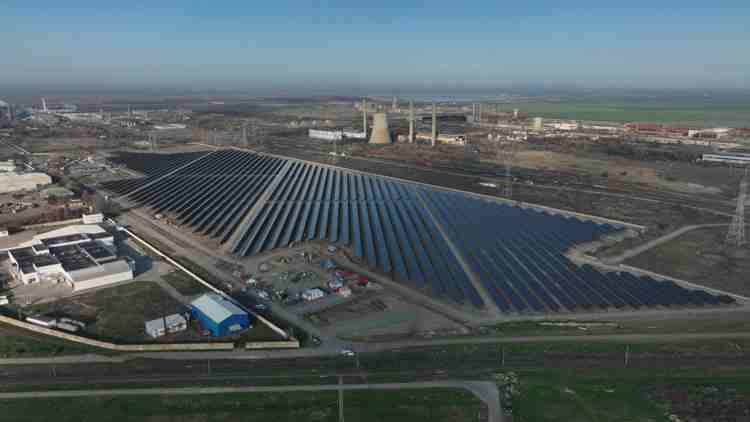
Tenaris inaugurates the first solar park in Romania, the largest self-consumption photovoltaic farm in the country, advancing the company’s decarbonization plans and paving the way toward carbon neutrality.
Romania’s appetite for clean energy is growing, as demonstrated by an increase in its 2030 targets for renewable energy to 38%, up from 30%. Wind, biomass, and solar are key sources, according to its updated National Energy and Climate Plan.
Among the country’s latest and largest projects is Tenaris’s new USD 21.5M Călărași solar park, inaugurated in April 2025 in a ribbon-cutting ceremony attended by the State Secretary from the Ministry of Energy, Pavel Nițulescu; the State Secretary from the Ministry of Environment, Cosmin Butuza; the Mayor of Călărași, Marius Dulce, as well as representatives of the National Energy Regulatory Authority, of the Prime Minister, of the Italian Embassy in Romania, and key customers and partners of Tenaris in the country.
The solar project will contribute to Tenaris’s ongoing decarbonization plan's to reduce its CO2 emissions by 30% by 2030.
Mihaela Popescu, President of Tenaris Eastern Europe, North Sea, and Sub-Saharan Africa, reinforced the company’s ongoing commitment to operating with care for the environment and the strategy behind the photovoltaic investment, which will cover part of the steel shop’s electricity needs.
“It reflects our efforts to maintain the competitiveness of our products in European and global markets, given the high energy prices in recent years, which have significantly affected energy-intensive consumers in Europe and especially in Romania,” shared Popescu. “The park enables us to offer our customers low-carbon products and actively contribute to the energy transition.”
Călărași solar park is a 20 MW farm that will directly supply a portion of the plant’s electricity with 100% renewable energy.
The steel shop utilizes Electric Arc Furnace technology, one of the lowest CO2-emitting routes for steel production, although it consumes a large amount of electricity. With this investment, Tenaris will integrate renewable energy into its operations, reducing the shop’s emissions by approximately 19,000 tons of CO2 per year, thereby further lowering the plant’s operational costs.
“We can estimate the average power to be about 5MW, which is an interesting share of consumption because it covers the electricity consumption of the auxiliary systems of the steelworks,” said Stefano Capone, Maintenance Principal Specialist at Tenaris, who explained that the full power capacity of the 20 MW park would be under optimal weather conditions.
Tenaris owned land near a high-voltage arrival station, close to its Călărași steel shop, and decided to move forward with the greenfield development of 24 hectares for the photovoltaic park. The USD 21.5 million investment was two years in the making and received both local and national support, with 30% covered by the European Union’s Recovery and Resilience Plan and Tenaris funding the remaining 70%.
“I’m proud to have been part of the team behind our new 20MW solar park in Călărași, now the largest self-consumption solar project in Romania,” said Ignacio Ristorto, Energy Senior Manager at Tenaris.
Ristorto described the project phases as complex, involving a competitive bidding process for EU funding, construction, integrating the park into the company’s internal and national grid systems, and testing for start-up.
The Călărași solar park is the third photovoltaic project in which the company has invested, alongside other projects in China and Italy. Capone worked alongside a professor at the Polytechnic of Milan to understand “the maximum size of the solar park for purely internal use of the energy produced. After energy analysis and basic design, we managed to get the connection to the substation authorized by the public network provider.”
A multidisciplinary team of experts was established to oversee the regulation, engineering, and maintenance of auxiliary services, making a valuable contribution to the project’s construction, remarked Capone.
Accordingly, Ristorto recognized the teamwork and collaboration behind the successful implementation, noting a high level of coordination among technical, administrative, and regulatory areas.

For Ristorto, the solar park represents more than a step forward in the company’s decarbonization efforts but a rewarding experience that supports both the business and a cleaner energy future.
Tenaris is not slowing down its investments to operate more sustainably, allocating 30% of its capital expenditures (CapEx) to support its decarbonization goals. The increased use of renewable energy is among the many actions the company is deploying to achieve its medium-term targets.
“We have always been focused on reducing our environmental footprint. This project allows us to reduce our indirect emissions, accompany our customers in their decarbonization efforts, and have a positive impact on the environment,” said Popescu.
Cold testing of the solar park, which focuses on the mechanical functions of the photovoltaic equipment, got underway in May. The team expects to start hot testing in June, a phase of commissioning that involves verifying the actual power generated from the park and its direct delivery to the steel shop performs as intended.